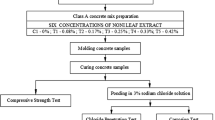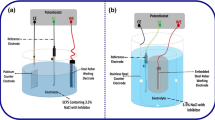Abstract
The most significant characteristic of corrosion inhibitors is to create chemical stability, when considering the fact that it affects concrete properties simultaneously. mild steel corrosion in 1 M HCl was studied in the presence different concentrations of Acacia longifolia, Areca catechu, Melastoma malabathricum, Elaeis guineensis and Cocos nucifera as green inhibitors and sodium nitrite (SN) as chemical inhibitor. Effects of green inhibitor utilized in this research has been investigated through conducting various tests on ordinary concrete, contaminated concrete and contaminated concrete modified with SN inhibitor and Areca catechu was found as the most efficient green inhibitor which was concluded through corrosion of mild steel and nitrogen content tests. The ordinary concrete has been contaminated by adding 5% magnesium sulphate and 5% sodium chloride by mixing water while casting. Results showed that the optimum percentage of A. catechu over concrete was 2% achieved by compressive, tensile and flexural strength test has been conducted at 7 and 28 days. Both chemical and green inhibitor showed acceptable compressive, tensile and flexural strength in contaminated concrete, while A. catechu added concrete showed superior performance when compared to SN.











Similar content being viewed by others
References
Abdulrahman, A. S., & Ismail, M. (2012). Evaluation of corrosion inhibiting admixtures for steel reinforcement in concrete. International Journal of the Physical Sciences, 7(1), 139–143.
Aguirre-guerrero, A. M., Mejía-de-gutiérrez, R., João, M., & Montês-correia, R. (2016). Corrosion performance of blended concretes exposed to different aggressive environments. Construction and Building Materials, 121, 704–716.
Al Zubaidy, E. A. H., & Al Tamimi, A. (2012). Reduction of corrosion process in steel bars using inhibitors. International Journal of Electrochemical Science, 7(7), 6472–6488.
ACI 318M–05. (2005). Building code requirements for structural concrete and commentary. American Concrete Institute, 318, 229–334.
ASTM C469/C469M. (2010). Standard test method for static modulus of elasticity and poisson’s ratio of concrete in compression. In Annual book of ASTM standards, Philadelphia, USA: American Society for Testing and Materials.
ASTM C617/C617M. (2012). Standard practice for capping cylindrical concrete specimens. In Annual book of ASTM standards, Philadelphia, USA: American Society for Testing and Materials.
ASTM C231/C231M-14. (2014). Standard test method for air content of freshly mixed concrete by the pressure method. In Annual book of ASTM standards, Philadelphia, USA: American Society for Testing and Materials.
Angst, U. M., Elsener, B., Larsen, C. K., & Vennesland, Ø. (2011). Chloride induced reinforcement corrosion: Electrochemical monitoring of initiation stage and chloride threshold values. Corrosion Science, 53(4), 1451–1464.
Arthur, D. E., Jonathan, A., Ameh, P. O., & Anya, C. (2013). A review on the assessment of polymeric materials used as corrosion inhibitor of metals and alloys. International Journal of Industrial Chemistry, 4(2), 1–9.
Asipita, S. A., Ismail, M., Majid, M. Z. A., Majid, Z. A., Abdullah, C., & Mirza, J. (2014). Green bambusa arundinacea leaves extract as a sustainable corrosion inhibitor in steel reinforced concrete. Journal of Cleaner Production, 67, 139–146.
British Standard Institution. (1983). Testing concrete. Method for determination of tensile splitting strength. BS 1881 Part 117: 1983.
British Standard Institution. (1983). Testing hardened concrete: Method for making test cylinder from fresh concrete. BS 1881 Part 110: 1983.
British Standard Institution. (1983). Testing concrete. Method for determination of compressive strength of concrete cubes. BS 1881 Part 116: 1983.
British Standard Institution. (1983). Method for determination of slump. BS 1881 Part 102: 1983.
British Standard Institution. (1996). Testing concrete: Recommendations for determination of the initial surface absorption of concrete. BS EN 1881 Part 208: 2013.
British Standard Institution. (2000). Testing hardened concrete: Shape, dimensions and other requierements for specimens and moulds. BS EN 12390 Part 1: 2000.
British Standard Institution. (2011). Testing hardened concrete: Compressive strength of test specimen. BS EN 12390 Part 3: 2011.
British Standard Institution. (2011). Testing concrete: Method for determination of water absorption. BS EN 1881 Part 122: 2011.
Buchweishaija, J. (2008). Phytochemicals as green corrosion inhibitors in various corrosive media: A review. Tanzania Journal of Science, 35, 77–92.
Chowdhury, P. C. (2004). Strategies for resisting corrosion of reinforcement in concrete. The Indian Concrete, 46–51.
Daniyan, A. A., Ogundare, O., Attahdaniel, B. E., & Babatope, B. (2011). Effect of palm oil as corrosion inhibitor on ductile iron and mild steel. The Pacific Journal of Science and Technology, 12(2), 45–53.
Das, R., & Debbarma, R. (2013). Effect of corrosion inhibitor on properties of concrete and mortar made with different admixtures. International Journal of Research in Engineering and Technology, 3, 294–298.
De Schutter, G., & Luo, L. (2004). Effect of corrosion inhibiting admixtures on concrete properties. Construction and Building Materials, 18(7), 483–489.
Deboucha, W., Oudjit, M. N., Bouzid, A., & Belagraa, L. (2015). Effect of incorporating blast furnace slag and natural pozzolana on compressive strength and capillary water absorption of concrete. Procedia Engineering, 108, 254–261.
Edoziuno, F. O., Odoni, B. U., Adediran, A. A. (2019). Analyses of the gravimetric and electrochemical effects of C16H13N3O3 on mild steel corrosion in 0.5 MH2SO4. Journal of Physics, 0–11, 1-11
Esah, H., Chukwuekezie, C., Idris, J., & Mohammad, I. (2013). Effect of green inhibitor on the corrosion behaviour of reinforced carbon steel in concrete. Journal of Engineering and Applied Sciences, 8(5), 326–332.
Fernandez, I., Lundgren, K., & Zandi, K. (2018). Evaluation of corrosion level of naturally corroded bars using different cleaning methods, computed tomography, and 3D optical scanning. Materials and Structures, 51(3), 1–13.
Gaidis, J. M. (2004). Chemistry of corrosion inhibitors. Cement and Concrete Composites, 26(3), 181–189.
Girardi, F., & Maggio, R. D. (2011). Resistance of concrete mixtures to cyclic sulfuric acid exposure and mixed sulfates: Effect of the type of aggregate. Cement and Concrete Composites, 33(2), 276–285.
Guo, B., Wang, X., Wang, Y., & Shao, Y. (2019). Study on the forecasting of the hot corrosion resistance of typical superalloys for aeroengines. Materials Science and Engineering, 685, 012025.
Ja, M., & Ja, T. (2017). Evaluation of maximum and minimum corrosion rate of steel rebars in concrete structures, based on laboratory measurements on drilled cores. Procedia Engineering, 193, 486–493.
Jiang, S., Gao, S., Jiang, L., Guo, M., Jiang, Y., Chen, C., et al. (2018). Effects of d eoxyribonucleic acid on cement paste properties and chloride-induced corrosion of reinforcing steel in cement mortars. Cement and Concrete Composites, 91, 87–96.
Kesavan, D., Gopiraman, M., & Sulochana, N. (2012). Green inhibitors for corrosion of metals: A review correspondence. Chemical Science Review and Letters, 1(1), 1–8.
Kharismadewi, D., & Yuliwati, E. (2020). Wuluh starfruit (Averrhoa bilimbi linn.) leaves extract as green corrosion inhibitor in reinforced steel. Journal of Physics: Conference Series, 1444, 1–7.
Mohammadi, B. (2013). Development of concrete water absorption testing for quality control school of graduate studies. Master of Applied Science, Concordia University Montreal, Canada.
Moreno, J. D., Bonilla, M., Adam, J. M., Borrachero, M., & Soriano, L. (2015). Determining corrosion levels in the reinforcement rebars of buildings in coastal areas. A case study in the Mediterranean coastline. Construction and Building Materials, 100, 11–21.
Mourya, P., Banerjee, S., & Singh, M. M. (2014). Corrosion inhibition of mild steel in acidic solution by Tagetes erecta (Marigold flower) extract as a green inhibitor. Corrosion Science, 85, 352–363.
Muthukrishnan, P., Prakash, P., Jeyaprabha, B., & Shankar, K. (2019). Stigmasterol extracted from Ficus hispida leaves as a green inhibitor for the mild steel corrosion in 1 M HCl solution. Arabian Journal of Chemistry, 12(8), 3345–3356.
Nwigbo, S. C., Okafor, V. N., & Okewale, A. O. (2012). Comparative study of Elaeis guiniensis exudates (Palm Wine) as a corrosion inhibitor for mild steel in acidic and basic solutions. Research Journal of Applied Sciences, Engineering and Technology, 4(9), 1035–1039.
Official methods of analysis 2011-04. (2011). Protein in raw and processed meats. p. 4–5.
Okeniyi, J. O., Loto, C. A., & Popoola, A. P. I. (2016). Effects of Phyllanthus muellerianus leaf-extract on steel-reinforcement corrosion in 3.5% NaCl-immersed concrete. Metals. https://doi.org/10.3390/met6110255.
Ormellese, M., Lazzari, L., Goidanich, S., Fumagalli, G., & Brenna, A. (2009). A study of organic substances as inhibitors for chloride-induced corrosion in concrete. Corrosion Science, 51(12), 2959–2968.
Palanisamy, S. P., Maheswaran, G., Kamal, C., & Venkatesh, G. (2016). Prosopis juliflora—a green corrosion inhibitor. Research on Chemical Intermediates, 42, 7823–7840.
Pradipta, I., Kong, D., Ban, J., & Tan, L. (2019). Natural organic antioxidants from green tea form a protective layer to inhibit corrosion of steel reinforcing bars embedded in mortar. Construction and Building Materials, 221, 351–362.
Qiao, G., Hong, Y., & Ou, J. (2015). Corrosion monitoring of the RC structures in time domain: Part I. Response analysis of the electrochemical transfer function based on complex function approximation. Measurement, 67, 78–83.
Raja, P. B., Ismail, M., & Ghoreishiamiri, S. (2016). Reviews on corrosion inhibitors—a short view. Chemical Engineering Communications, 203(9), 1145–1156.
Rani, B. E. A., Basu, B. B. J. (2012). Green inhibitors for corrosion protection of metals and alloys: An overview. International Journal of Corrosion, 2012(i), 1–15.
Sangeetha, M., Rajendran, S., Sathiyabama, J., Krishnaveni, A., Shanthy, P., Manimaran, N., et al. (2011a). Corrosion inhibition by an aqueous extract of Phyllanthus amarus. Portugaliae Electrochimica Acta, 29(6), 429–444.
Sangeetha, M., Rajendran, S., Sathiyabama, J., Krishnaveni, A., Shanthy, P., Manimaran, N., et al. (2011). Corrosion Inhibition by an aqueous extract of Phyllanthus amarus. Portugaliae Electrochimica Acta, 29(6), 429–444.
Shahid, M. (2011). Corrosion protection with eco-friendly inhibitors. Advances in Natural Sciences: Nanoscience and Nanotechnology, 2(4), 043001.
Söylev, T. A., & Richardson, M. G. (2008). Corrosion inhibitors for steel in concrete: State-of-the-art report. Construction and Building Materials, 22(4), 609–622.
Umoren, S. A., Obot, I. B., Israel, A. U., Asuquo, P. O., Solomon, M. M., & Eduok, U. M. (2014). Inhibition of mild steel corrosion in acidic medium using coconut coir dust extracted from water and methanol as solvents. Journal of Industrial and Engineering Chemistry, 20, 3612–3622.
Uwah, I. E., Okafor, P. C., & Ebiekpe, V. E. (2013). Inhibitive action of ethanol extracts from Nauclea latifolia on the corrosion of mild steel in H2SO4 solutions and their adsorption characteristics. Arabian Journal of Chemistry, 6(3), 285–293.
Wu, X., Li, L., Li, H., Li, B., & Ling, Z. (2018). Effect of strain level on corrosion of stainless steel bar. Construction and Building Materials, 163, 189–199.
Zhao, X. D., Yang, J., & Fan, X. Q. (2010). Review on research and progress of corrosion inhibitors. Applied Mechanics and Materials, 44–47, 4063–4066.
Zhou, J. L., Ou, Z. W., Chen, Q., & Chen, Y. (2011). The influence of admixtures on the corrosion protection afforded steel reinforcement in seawater-and-seasand concrete. Advanced Materials Research, 250–253, 81–89.
Zhu, W., François, R., Sun, C., & Dai, J. (2017). Influences of corrosion degree and corrosion morphology on the ductility of steel reinforcement. Construction and Building Materials, 148, 297–306.
Znini, M., Majidi, L., Bouyanzer, A., Paolini, J., Desjobert, J. M., Costa, J., et al. (2012). Essential oil of Salvia aucheri mesatlantica as a green inhibitor for the corrosion of steel in 0.5M H 2SO 4. Arab. J. Chem., 5, 467–474.
Acknowledgements
The authors would like to dedicate the acknowledgement of gratitude to Ministry of Education Malaysia because of the financial support Grant no: 4S090. Technical staffs from department of structure and materials, Faculty of Civil Engineering, RMC UTM and Institute of bio-product and development of UTM are also appreciated.
Author information
Authors and Affiliations
Corresponding author
Ethics declarations
Conflict of interest
On behalf of all authors, the corresponding author declares that there is no conflict of interest that could have appeared to influence the work reported in this paper.
Additional information
Publisher's Note
Springer Nature remains neutral with regard to jurisdictional claims in published maps and institutional affiliations.
Rights and permissions
About this article
Cite this article
Ghoreishiamiri, S., Raja, P.B., Ismail, M. et al. Mechanical properties of contaminated concrete inhibited by Areca catechu leaf extract as a green corrosion inhibitor. Asian J Civ Eng 21, 1355–1367 (2020). https://doi.org/10.1007/s42107-020-00283-7
Received:
Accepted:
Published:
Issue Date:
DOI: https://doi.org/10.1007/s42107-020-00283-7




